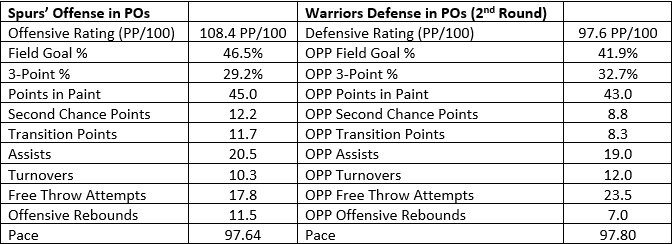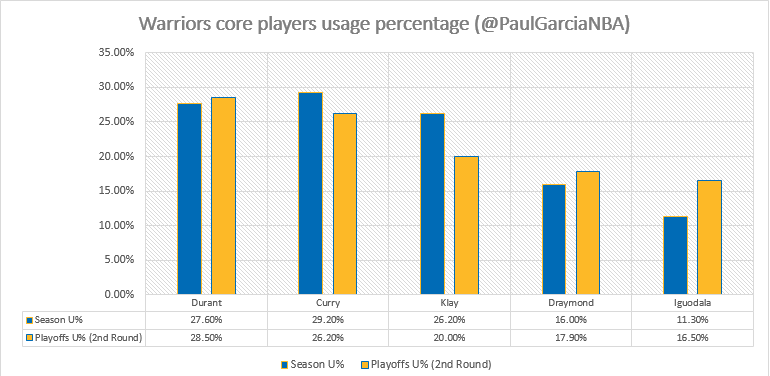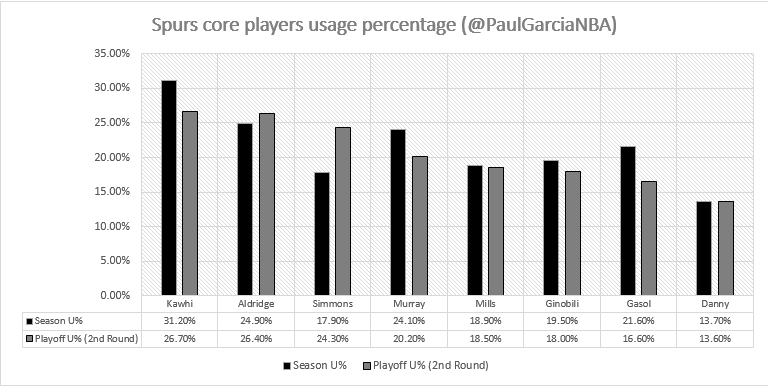After defeating the Memphis Grizzlies and Houston Rockets in two six game-series, the San Antonio Spurs are on to the Western Conference Finals, where they’ll play the Golden State Warriors, who swept both the Portland Trail Blazers and Utah Jazz. While the Warriors are completely healthy, the Spurs will be without Tony Parker, who ruptured his quadriceps tendon in the second round and is now out for the rest of the playoffs. The Spurs’ lone All-Star Kawhi Leonard might also not be 100%, after he sustained a left ankle sprain late in the second round as well.
During the regular season, the Spurs defeated the Warriors 2-1 in the season series, but the data and matchups aren’t very reliable because of when the games took place and since both teams were missing key pieces in all three meetings. As has been done through the playoffs, it’s time to take a quantitative and qualitative look at the Spurs and Warriors’ playoff matchup, and at the end, a series prediction will be provided.
The Warriors
The first table below displays the Warriors’ depth chart based off their second round against the Jazz. The Warriors have been running a 10-man rotation, with McGee and Clark getting spot minutes.

The Dubs usually start first and third quarters with their starting five, and they’ll play some lineups with McGee at center while Draymond plays at the 4. However, for other minutes in the game, the Warriors like to go small with lineups with one traditional 5 or with West at the 5. The Warriors’ Death Ball lineup, which consists of Curry, Thompson, Iguodala, Durant and Draymond outscored the Jazz by 24.0 Points Per 100 Possessions in their 23 minutes on the floor together.
The next chart shows who the Warriors’ main playmakers were in the second round, as each player listed below played over 100 minutes in the last series.
Unlike the Rockets, who mainly relied on Pick-and-roll action to drive their offense, the Warriors rely on more motion based sets, which are even tougher to defend, as there’s constant screening, ball and player movement through each possession until shots open. As a last resort in a possession, the Warriors have five ball handlers who can easily initiate a P&R and either score or pass effectively in any scenario.
This next chart shows where the Warriors mainly got their points from in the second round of the playoffs.
| Area | |
| Points in the Paint | 36.0% |
| 3-Pointers | 27.7% |
| Free Throws | 17.8% |
| Mid-Range | 18.5% |
Against the Rockets, the Spurs could try to defensively give them a shot they didn’t value – the mid-range jumper. As you can see, the Warriors’ offense will gladly welcome any type of shot a defensive is giving to them. The Spurs’ defense will still probably settle for making the non-paint two the shot they want the Warriors to take, since Golden State can be deadly from three and they have the athletes to constantly score effectively from the paint and shooters to nail any free points from the free throw line.
Looking at quantitative data, the table below shows how the Warriors’ offense produced in several categories against the Jazz, and how the Spurs’ defense fared in those same categories during their series against Houston when Tony Parker was off the floor.

The Spurs’ defense is surely going to be tested, as the Warriors are scoring 10 more PP/100 than San Antonio was allowing to Houston. The Warriors also scored 10 more points at the rim than the Rockets, and the transition defense for the Spurs must remain a key for them, since Golden State scored seven more points on the break than San Antonio allowed to Houston. The assists are also a main key for the Warriors, as mentioned by how they move the ball and look for good to great shots. The Warriors played at a pace like the Spurs’ series against the Rockets, but during the regular season, the Warriors preferred to play five possessions faster, which means they might be able to bring an uptick to the tempo of the games.
After watching film of the Warriors’ four games against the Jazz, here were a few notes I took from that series on what Golden State likes to do on offense.
Observations from Warriors’ series vs Utah
– Draymond pushes the break – Draymond is almost like another point guard out on the floor, as he is very comfortable grabbing a defensive rebound and pushing the break to find outlet shooters or cutters for layups/dunks. If Draymond sees the rim wide open, he can go coast to coast for scoring basket as well. Something else he does is outlet the ball almost full court if he sees a teammate leaking out.
– McGee lob dunks – When the Warriors swap centers with Pachulia for McGee, the Spurs’ defense must treat McGee like he’s Clint Capela, as McGee has the skill set to quickly jump into the air and finish alley-oop dunks off the P&R or on cutting action. Against Capela, the Spurs had their center drop back near the rim and the weakside defender snuck in on the roll to prevent Capela from jumping early. The Spurs might still incorporate this strategy, but if the Warriors ball handler kicks to the corner, that’s usually a shooter waiting or another playmaker to drive and kick.
– Watch Weakside action – The Warriors like to keep all five players busy on most possessions. The Spurs’ defense on the weakside must stay focused on their assignments because even if the ball is on the strong side of the floor with the Warriors running a set, on the weakside, there’s probably action going on at the same time to get someone like Thompson, Curry, or Durant open shots off flare, pin-down, or curl screens.
– Switching on defense – Outside of Pachulia and McGee, the Warriors are very comfortable with different lineups switching any type of P&R or off ball screening action, even if it means a smaller defender being put on a taller offensive player for a few seconds of the shot clock. The Spurs’ spacing will be important to try to attack some of the Warriors’ point guards like Curry or Clark if they get switched onto Leonard, Simmons, or Aldridge. On P&Rs, Pachulia and McGee like to drop back, so the mid-range jumper could available for the Spurs’ ball handlers.
– Counter with size – Since the Warriors like to play smaller lineups for portions of the game, the Spurs might try to counter with keeping two of their big men on the floor, and even if they play with just one big, that player must take advantage of the available offensive rebounds that could be present. Though his rim protection was valuable against the Rockets, Gasol might only be able to play when one of McGee, West or Pachulia are on the floor. In lineups where West is the 5, the Spurs should attack the rim like they did to the Rockets when they ran Ryan Anderson at the 5.
– Possible adjustment for Warriors’ Death Ball lineup – When the Warriors do use their Death Ball lineup, the Spurs will probably to try to defend it with Aldridge or Lee at the 5. If neither big can play effectively, one adjustment the Spurs could make is going small 1-5, as Mo Dakhil recently wrote, with possibly putting Leonard at the 5, so the Spurs could switch 1-5.
How did the Warriors lose 15 games this season?
Next, looking back at their regular season data, here were some trends that led to the Warriors losing 15 games this season.
– Off night from three – In their wins, the Warriors shot 40.9% from three. However, in their losses, the Warriors shot 26.7% from three. In looking at the types of threes the Warriors made in losses, 21.3% of the Warriors made 3s in losses were unassisted, while in wins, that number was only at 15.9%. It’s clear those defenses did their best to take away the Warriors’ catch-and-shoot spot-ups threes. Something else opponents did to the beat the Warriors was shoot 38.1% from three, compared to the Warriors normally holding opponents to 31.0% from three in Warriors wins.
– Exploit Warriors’ lack of size – In losses, the Warriors had trouble on the boards, as they only had a 46.5% rebound percentage. In wins, the Warriors’ rebound percentage shot up to 51.5%. Opponents scored 15.9 second chance points and grabbed 28.7% of their offensive rebounds in Warriors losses, compared to 13.5 second chance points and 24.2% offensive rebounds in Warriors wins. Opponents also scored 48.9 points in the paint during Warriors losses, compared to 44.7 PITP during Warriors wins.
– Muck up the game – Limiting the Warriors’ assist was key in their losses, as they only tallied 24.1 in losses, compared to 31.8 in wins. The Warriors also turned the ball over almost two more times in losses compared to wins. Opponents limited the Warriors’ fast break points, as they held the Warriors to 17.7 in losses, compared to Golden State getting 23.7 in wins. Opponents also moved the ball more against the Warriors, as opponents tallied 25.4 assists in Warriors losses, but only 22.1 in Warriors wins.
Next, let’s look at some observations on the Warriors’ four All-Stars against the Spurs during the regular season.
Durant
Durant’s only action against the Spurs came in the first game of the season. His main defenders that night were Anderson, Simmons, and Leonard. He was able to post and score over Anderson, while Gasol and Aldridge had trouble staying with him when they were switched onto him. Durant also did an excellent job of exploiting mismatches. With the Spurs likely switching, he may see Leonard, Danny and Simmons more in the WCF.
Curry
Curry played in two games against the Spurs and he was mainly guarded by Parker, Ginobili, Simmons and Mills. Curry liked to get switches with Gasol defending him, while he also had little trouble getting by Aldridge, Lee and Ginobili on drives. The interesting to player to watch in this matchup is how Murray will fare when guarding Curry. He has the length to try to stay in front of him, but it’s unclear if he’ll have the discipline and focus to constantly chase Curry off multiple screens in possessions. By the second game against Curry, the Spurs switched most of his P&Rs. He drew lots of eyes on him off the ball, which allowed for some backdoor cuts near the rim. Mills, Danny, Simmons, Ginobili, Leonard, and Murray will all possibly spend some time guarding Curry on different possessions.
Thompson
Thompson played in two games against the Spurs and was mainly guarded by Parker, Ginobili, Simmons, Leonard, and Danny. The Spurs must watch him in transition as he looks for the 3-ball on the break, and he can get a small or big defender on him. Even when he gives up the ball, he quickly looks for an open three if the defense rests just a bit. The Spurs switched all his off-ball screens as well.
Draymond
Draymond played in two games against the Spurs and was first guarded by Aldridge in the first game, and then Leonard and Danny in the second game. Having a wing guard Draymond allows the Spurs’ defense to switch on his P&Rs with Curry, Thompson or Durant. The Spurs left him open on 3s and will likely continue to do so, but this also allows him to quarterback from the elbow or top of the arc and find shooters going off screens. Draymond is also excellent as a roll man to finish or kick out on the drive.
The Spurs
Based on how they closed the series against the Rockets, here’s the Spurs’ depth chart.

Since the Warriors play small and tend to help and get back on their assignment, it wouldn’t be surprising to see some minutes for Bertans in this series for spacing, especially when the Spurs look to the Aldridge post-up. The key would be how long Bertans can survive on defense in potential switches with Curry, Durant and Thompson.
The next chart shows the Spurs’ key playmakers based off their second-round series against the Rockets, with players who played over 100 minutes, and including Murray, who has seen more minutes since Parker will now be out.
Three X-factors for the Spurs are Aldridge, Simmons and Murray. It’s a big if, but if Aldridge can continue to dominate in the post like he did in game six against the Rockets, he would give Leonard an All-Star level second option, so that the burden wouldn’t fully be on Leonard to have to try to create out of the P&R, post or isolation. Simmons and Murray are also potential x-factors because of how they’ve been playing lately. They both give the Spurs’ offense two more ball handlers who can get to the rim and create for themselves or others. While they looked dangerous against the Rockets, the Warriors have the best defense in the playoffs and are much more disciplined, so it’ll be interesting to see if Simmons and Murray can provide Leonard with some help as ball handlers.
The next chart shows where the Spurs’ points came from in the second round against the Rockets with Parker off the floor.
| Area | |
| Points in the Paint | 49.8% |
| 3-Pointers | 21.0% |
| Free Throws | 14.0% |
| Mid-Range | 15.1% |
As mentioned, with the Spurs getting more production from Aldridge and Simmons, San Antonio turned into a team that mostly got their points at the rim. The sacrifice was outside shooting, but if Danny, Ginobili and Mills can hit a decent percentage of their shooting, the Spurs can have a well-equipped inside-out attack.
The next chart shows the Spurs’ offensive numbers in specific categories and the Warriors’ defense against those categories in the second round of the playoffs.

As mentioned, the Warriors have been playing the best defense in the playoffs. Once the Spurs were able to move the ball side to side and continue to attack the Rockets’ weakest defender in Harden, the offense started to open up for San Antonio. Unfortunately, the Warriors are very disciplined on defense and while Curry might not be the best defender, he at least puts forth the effort to try to make it difficult for defenses to target him. The Warriors are very active on defense by constantly swarming the post and scrambling on the outside while switching screen action. It’s uncertain how many minutes Gasol can play in this series, but the Spurs will need his offensive rebounding ability, or that of Aldridge to try to use their size advantage against the Warriors.
Next, here were some notes on the Spurs’ three main playmakers in their games against the Warriors during the regular season.
Leonard
The Warriors have four defenders to constantly throw at Leonard – Durant, Thompson, Draymond and Iguodala. The Warriors switched Leonard’s P&Rs as the ball handler and they didn’t send much help on his post-ups. Leonard did get some open and semi-contested mid-range looks against the Warriors. The Spurs might look to take a page from the Cleveland Cavaliers’ playbook and try to run more 3-1 P&Rs against the Warriors to try to get Curry matched up onto Leonard as much as possible, just like the Cavs do with LeBron James.
Aldridge
Aldridge was mainly defended by Draymond, Pachulia, McGee and West. He was inconsistent in the post against Draymond, as he could back him down on some possessions, but on others, he couldn’t move Draymond at all. He should get a healthy dose of Mid-Range jumpers, since the Warriors’ bigs focus more on the ball handlers on P&Rs. Aldridge should be able to attack the offensive glass when he doesn’t take shots and he’s near the rim.
Simmons
Simmons played mainly in the opening game of the season against the Warriors’ core players, and he saw Curry, Iguodala, Durant and Thompson guard him. He got most of his points in transition, but in the half court, he did show ability to attack the Warriors’ wing defenders off the dribble and get to the rim. The Warriors left him open for three just like the Rockets did. As mentioned, since the Warriors don’t have a lot of experience against Simmons, he can make the Spurs a different team than on paper with his ability to attack off the dribble from the 3-point line or create out of the P&R.
Series Prediction
In the regular season, the Warriors had the best offense and second best defense. In the playoffs, they have the second-best offense and best defense. There’s not many holes in this Golden State team on either end of the floor. The Spurs may be able to exploit the Warriors’ lack of size for one or two games, but in the end, the Warriors just have too many counters that they haven’t even needed to use yet in the playoffs. I think the Spurs will be able to get two games against the Warriors, but that’s it. So, I’m picking the Warriors to win the series in 6 games.
If Aldridge can play like an All-Star and Murray and Simmons can also put pressure on the Warriors’ defense with their attacking ability, that could give the Spurs a chance. But, that’s a big IF that has to be seen to be believed for four games in seven tries.
Add The Sports Daily to your Google News Feed!
![[Rd3-Playoffs] GSW (promo2)](https://thesportsdaily.com/wp-content/uploads/2017/05/rd3-playoffs-gsw-promo2.jpg)

